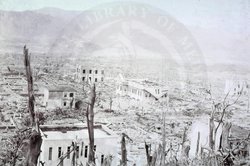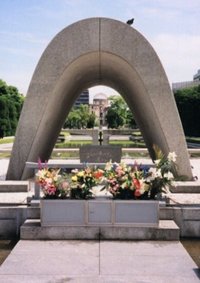Hiroshima
|
|
Hiroshima-castle-japan.jpg
The city of Hiroshima (広島市; -shi) is the capital of Hiroshima Prefecture, and the largest city in the Chugoku region of western Honshu, the largest of Japan's islands. Geographical location Template:Coor dms (City Hall). It is best known throughout the world as the first city in history subjected to nuclear warfare.
As of 2004, the city's mayor is Tadatoshi Akiba.
| Contents |
History
HiroshimaGembakuDome.jpg
Hiroshima was founded in 1589, on the coast of the Seto Inland Sea, and became a major urban center during the Meiji period. The city is located on the broad, flat delta of the Ota River, which has 7 channel outlets dividing the city into six islands which project into Hiroshima Bay. The city is almost entirely flat and only slightly above sea level; to the northwest and northeast of the city, some hills rise to 700 feet.
Hiroshima was founded by Mori Motonari as his capital. About a half century later, after the Battle of Sekigahara, his grandson and the leader of the West Army Mori Terumoto lost the battle. The winner Tokugawa Ieyasu deprived Mori Terumoto of most of his fiefs including Hiroshima and gave Aki province to another daimyo who had supported him.
Finally Asano was appointed the daimyo of this area and Hiroshima served as the capital of Hiroshima han during the Edo period. After the han was abolished the city became the capital of Hiroshima prefecture.
During the First Sino-Japanese War, Hiroshima emerged as a major supply and logistics base for the Japanese military, a role that it continued to play during World War II. The city was heavily damaged in World War II by the nuclear weapon Little Boy, the second such device to be detonated, and the first ever used in military action. The American atomic bombings of Hiroshima and Nagasaki was the major factor leading to the surrender of the Japanese government six days after the latter attack.
After the nuclear attack, Hiroshima was rebuilt as a "peace memorial city," and the closest surviving building to the location of the bomb's detonation was designated the Hiroshima Peace Memorial. The city government continues to advocate for the abolition of nuclear weapons, writing a letter of protest every time a nuclear weapon has been detonated anywhere in the world since the city's bombing, and has advocated more broadly for world peace.
Hiroshima gained city status on April 1, 1889 and was designated on April 1, 1980 by government ordinance.
After the war
Hiroshima was rebuilt after the war, with new modern buildings rising all over the city. In 1949, Hiroshima was proclaimed a City of Peace by the Japanese parliament, at the initiative of its mayor Shinzo Hamai (b. 1905-d. 1968). As a result, the city of Hiroshima was receiving more international attention as a desirable location for holding international conferences on peace as well as social issues. As part of that effort, the Hiroshima Interpreters' and Guide's Association (HIGA) was established in 1992 in order to facilitate translation services for conferences, and the Hiroshima Peace Institute was established in 1998 within the Hiroshima University. In 1994, the City of Hiroshima hosted the Asian Games.
Also, as a result of the atomic bombing, Hiroshima began to receive donations of streetcars from all over Japan. (After World War II, Japanese cities - like British ones - were anxious to get rid of their streetcar systems due to damage to the infrastructure, and so there were plenty of streetcars available to give away.) Hiroshima thus rebuilt its streetcar system along with the rest of the city, and thus Hiroshima is the only city in Japan with an extensive streetcar system (although other cities have streetcar lines). Some streetcars that survived the war - and the nuclear attack - were put back into service, and four of these are still running today. For the most part, however, Hiroshima has updated its streetcars over the years.
PaperCranes.jpg
Tens of thousands of people marked the 40th anniversary of the atomic bombing of the city on August 6, 1985.
Attractions
Okonomiyaki_2.jpg
Baseball fans immediately recognize the city as the home of the Hiroshima Toyo Carp. Six-time champions of Japan's Central League, the team has gone on to win the Japan Series three times.
Sanfrecce Hiroshima is the city's J. League soccer team.
Hiroshima's rebuilt castle (nicknamed Rijō, meaning Koi Castle) houses a museum of life in the Edo period.
Itsukushima ("Miyajima") Shrine is in the town of Miyajima, on the island of Itsukushima, across from Hiroshima. Its large red "floating gate" is one of the best known sights of Japan.
Hiroshima is known for its version of okonomiyaki, called "Hiroshima-yaki" or "Hiroshima pizza." The Hiroshima version of okonomiyaki is unique for its inclusion of yakisoba noodles.
Wards
Hiroshima has 8 wards (ku):
Demographics
As of 2003, the city has an estimated population of 1,136,684 and the density of 1532.44 persons per km². The total area is 741.75 km².
Industry
Mazda Motor Company, now controlled by the Ford Motor Company, is by far Hiroshima's dominant company. Mazda makes many models in Hiroshima for worldwide export, including the popular MX-5/Miata and Mazda RX-7. Other Mazda factories are in Hofu, Yamaguchi and Flat Rock, Michigan.
Sister cities
- Chonqing, China
- Daegu, South Korea
- Hannover, Germany
- Honolulu, America
- Montreal, Canada
- Volgograd, Russia
Further reading
- Robert Jungk, Children of the Ashes, 1st Eng. ed. 1961
- Gar Alperovitz, The Decision to Use the Atomic Bomb, ISBN 067976285X
- John Hersey, Hiroshima, ISBN 0679721037
See also
- Hiroshima Peace Memorial
- Atomic bombings of Hiroshima and Nagasaki
- Enola Gay
- Yoshito Matsushige
- Nagasaki
- Barefoot Gen
External links
- Official website (http://www.city.hiroshima.jp/index-E.html) in English
- Devotion to the Cause of Peace (http://www.city.hiroshima.jp/shimin/heiwa/peaceenglish.html) - The City of Hiroshima
- Hiroshima Hiroden Streetcars (http://www.subways.net/japan/hiroshima.htm)
- GAP Activity Projects (http://www.gap.org.uk/uwhere/fe_jap_top.html) projects for male volunteers in the Red Cross Hiroshima Hospital and Kummanoto Hospital, caring for survivors of the atomic bomb
- "Better World Links" portal site page on Hiroshima and Nagasaki (http://www.betterworldlinks.org/book80.htm)
- Hiroshima (http://www.japaneselifestyle.com.au/travel/hiroshima.htm) Travel Guide
- Hiroshima City (http://apike.ca/japan_hiroshima.html) Travel and Event Guide
- Remembering the Korean Atom Bomb Victims (http://montages.blogspot.com/2004/08/remembering-korean-atom-bomb-victims.html)
Template:Hiroshimaar:هيروشيما bg:Хирошима da:Hiroshima de:Hiroshima eo:Hiroŝimo es:Hiroshima fi:Hiroshima fr:Hiroshima he:הירושימה id:Hiroshima, Hiroshima it:Hiroshima ja:広島市 la:Hirosima nl:Hiroshima no:Hiroshima pl:Hirosima pt:Hiroshima simple:Hiroshima sv:Hiroshima


